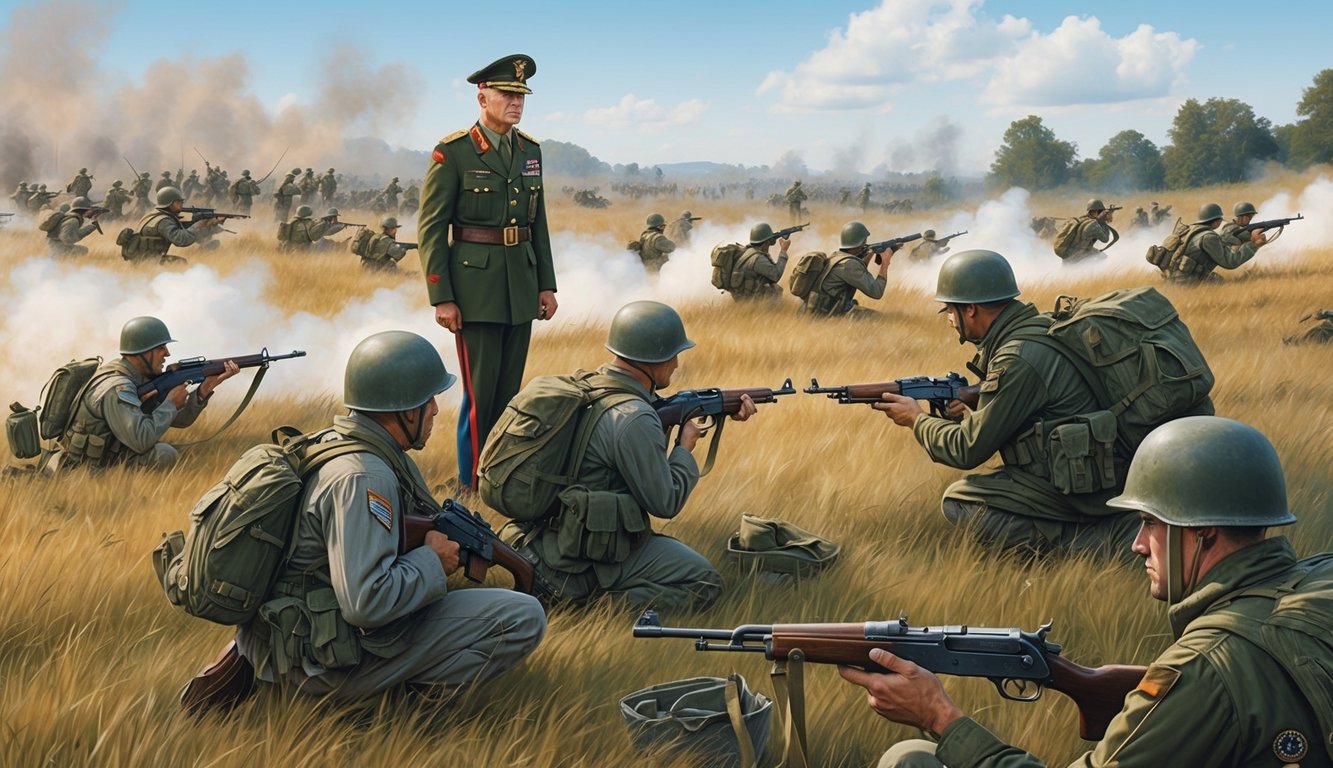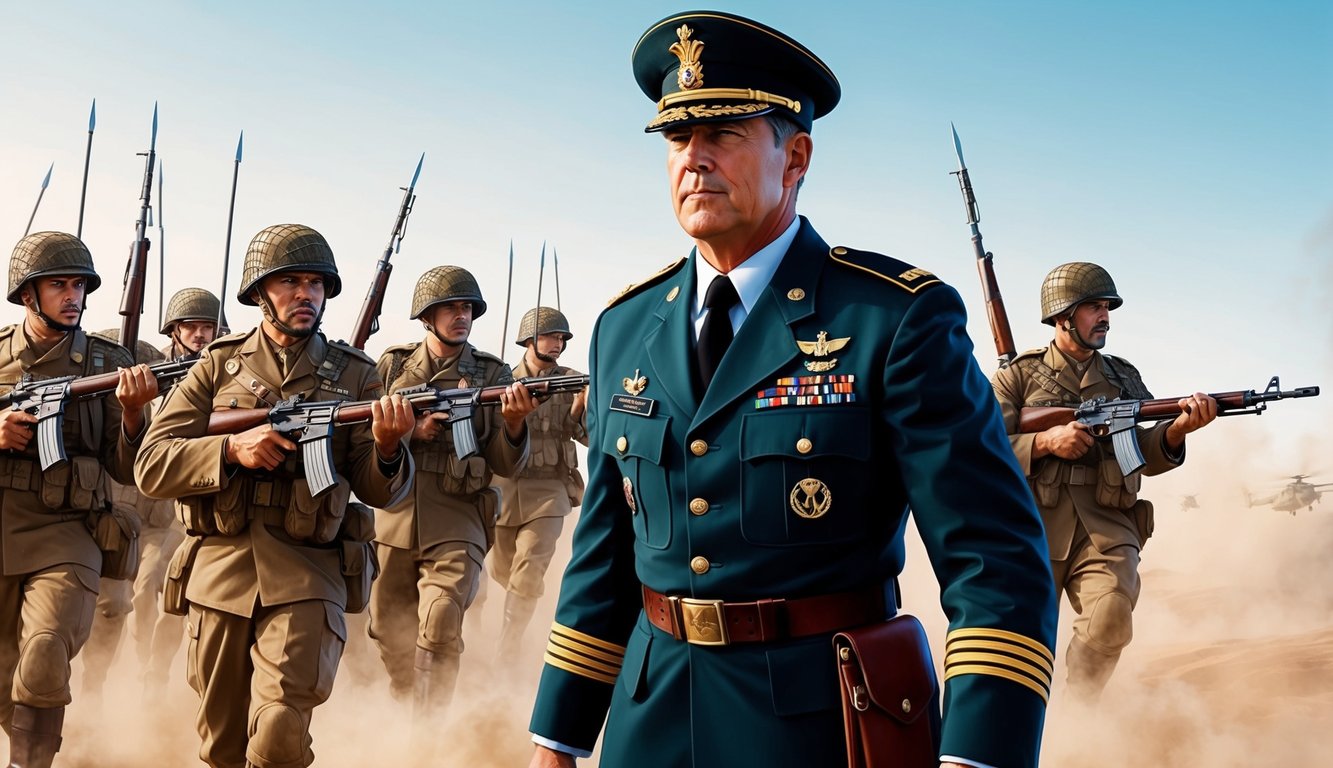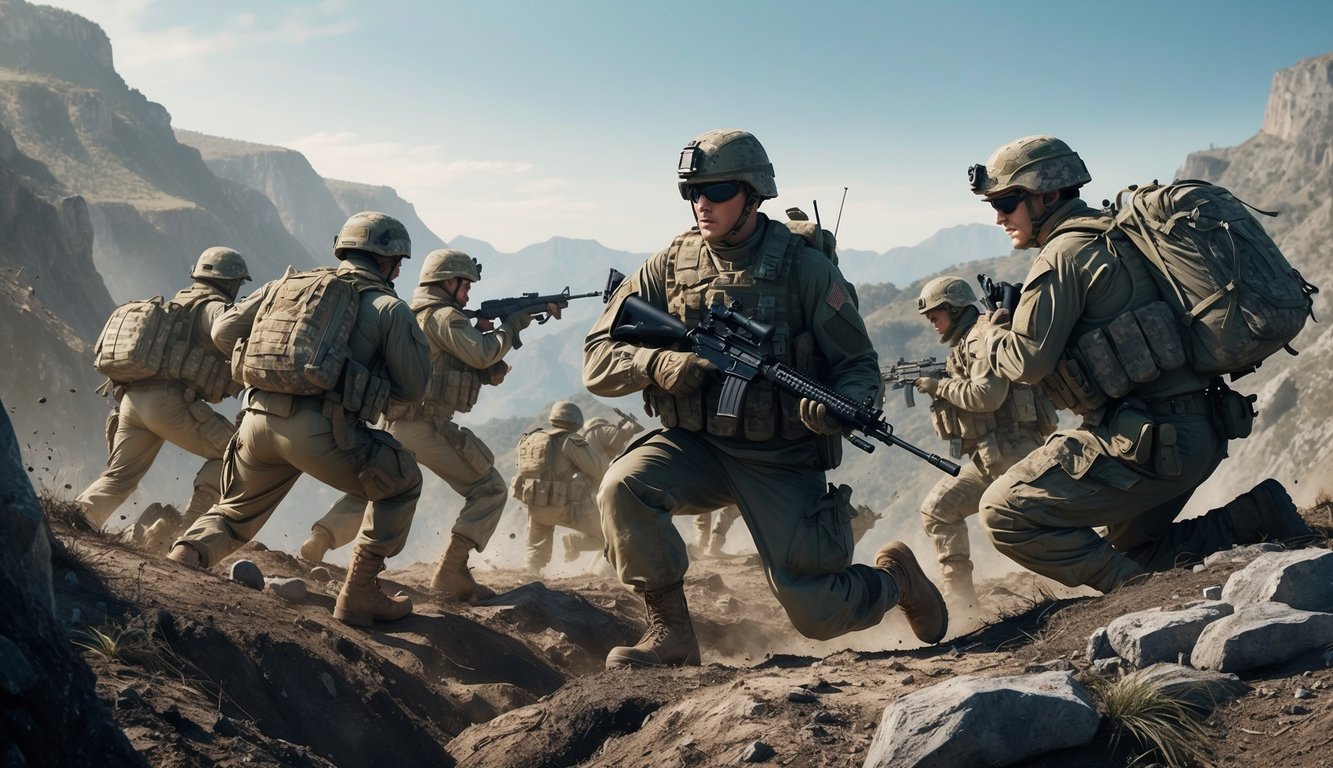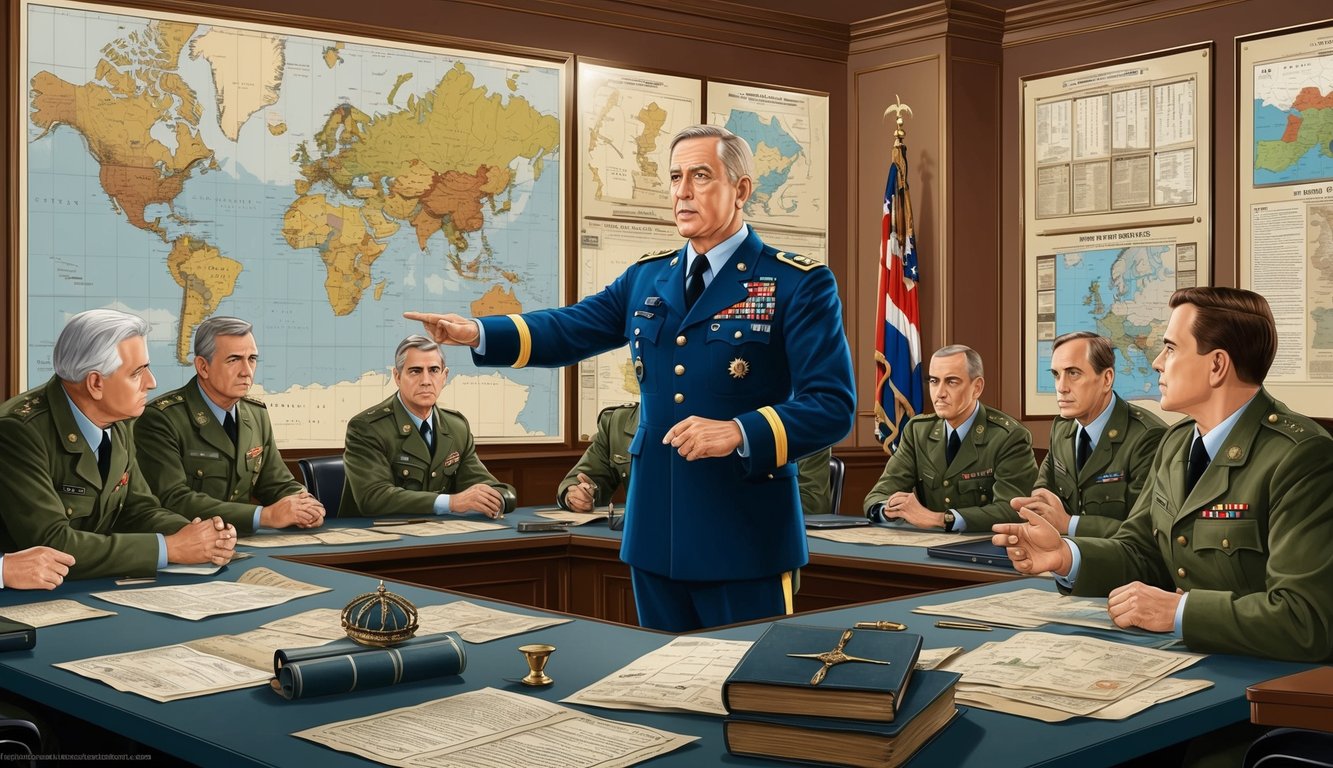The history of military leadership has played a crucial role in influencing nations and global events over the centuries.
The success of numerous battles and campaigns hinged on the ability to command, inspire, and strategize. Effective military leadership merges tactical expertise, strategic insight, and the capability to rally troops even amid challenges.
Throughout history, military leaders have highlighted the significant effect of strong leadership on the outcomes of battles and the global landscape.
From ancient warriors to present-day generals, these leaders embodied qualities such as bravery, adaptability, and foresight. Their choices and actions have not only shaped the destinies of armies but have also contributed to the evolution of military strategies and organizational frameworks.
Studying leadership in military history provides critical insights into the progression of warfare, the significance of strategic planning, and the human elements essential for success in high-pressure scenarios.
These insights are applicable beyond the battlefield, offering lessons relevant to various leadership roles in civilian contexts.
Key Takeaways
- Military leadership entails a mix of tactical skill, strategic foresight, and the capacity to inspire troops
- Historical military figures have significantly influenced warfare doctrine and organizational practices
- Exploring military leadership yields important lessons for various leadership positions
Understanding Military Leadership
Military leadership is crucial to the effectiveness and unity of armed forces.
It encompasses the guidance of personnel, making pivotal decisions, and achieving strategic goals in high-pressure situations.
Defining Leadership in a Military Context
Military leadership transcends mere orders; it focuses on inspiring troops, cultivating discipline, and making tough decisions during crisis situations.
Effective military leaders balance authority with empathy and technical skills with strategic vision.
Leadership in the military follows a hierarchical structure, ensuring clear lines of authority and accountability. However, it is not solely about rank; true leaders earn respect through their actions and decision-making.
Adaptability is also a key facet of military leadership.
Being able to swiftly alter plans in response to changing circumstances, whether in combat or peacetime, is essential.
Evolution of Leadership Concepts
Leadership paradigms within the military have undergone significant evolution.
Earlier models emphasized top-down, authoritarian approaches, whereas contemporary military leadership theories now advocate for more collaborative and adaptive styles.
A notable trend is the implementation of mission command in modern military forces, which empowers lower-level leaders to make decisions based on their understanding of the overarching commander’s intent.
Technological advancements have further reshaped military leadership roles, requiring consideration of cybersecurity, drone operations, and information management in decision-making.
Roles and Responsibilities of Military Leaders
Your main responsibility as a military leader is to fulfill the mission while ensuring the welfare of your troops.
This dual focus differentiates military leadership from many civilian roles.
Training and developing your subordinates is a vital aspect of your duties.
This encompasses not only technical capabilities but also character development and ethical decision-making.
In combat, you must quickly make life-or-death decisions, while in non-combat situations, your responsibilities may include strategic planning, resource allocation, and diplomatic engagement.
Military leaders are also expected to embody the core values of their service, serving as exemplars of integrity, courage, and commitment for their troops.
Historical Perspectives

Throughout history, military leadership has been instrumental in shaping historical trajectories.
Great commanders have left enduring legacies that continue to influence contemporary strategy and tactics.
Ancient Military Leaders
Some of the most renowned military figures emerged in ancient history.
Alexander the Great is notable for his unparalleled conquests across vast territories.
His strategic brilliance and ability to motivate troops have set a gold standard for future leaders.
Sun Tzu’s “The Art of War” stands as an essential text of military philosophy.
His insights on deception, adaptability, and understanding one’s adversary remain relevant to leaders worldwide.
Hannibal’s audacious Alpine crossing with elephants during his campaign against Rome illustrates innovative military thinking.
These ancient leaders established foundational military strategies that resonate through the ages.
Medieval Military Stratagems
The medieval era saw a focus on chivalry and valor within military leadership.
Richard the Lionheart exemplified these ideals throughout the Crusades.
His personal courage motivated his forces, although his absence from England led to political challenges.
Saladin, Richard’s Muslim counterpart, was distinguished for his chivalrous demeanor and strategic capabilities, successfully uniting Muslim forces to reclaim Jerusalem from the Crusaders.
In contrast, Genghis Khan’s leadership style showcased brutal effectiveness in conquest, tempered by a meritocratic structure within his ranks.
His tactics transformed warfare and significantly influenced Eurasia.
From Renaissance to Revolution
The Renaissance heralded military innovations, with figures like Gustavus Adolphus of Sweden revolutionizing army organization and tactics through mobile artillery and combined forces.
Napoleon Bonaparte’s leadership represented a critical juncture in military history, exemplified by his adept use of speed, surprise, and tactical concentration, which rendered him nearly invincible for many years.
Frederick the Great of Prussia also made his mark with a disciplined army and personal leadership on the battlefield, augmenting Prussia’s status as a significant European power.
Modern Warfare and Leadership
World War II introduced notable leaders like Winston Churchill and Dwight D. Eisenhower.
Churchill’s unwavering speeches lifted British morale during challenging times, while Eisenhower’s adept management of complex allied operations proved vital.
During the Cold War, a paradigm shift towards strategic deterrence emerged, where leaders balanced military preparedness against nuclear threat risks.
Today’s military leaders grapple with modern challenges such as asymmetric warfare, cyber threats, and rapid technological change.
Navigating intricate political landscapes is as critical as battlefield strategy.
Influential Military Leaders and Their Impact
Military leaders have profoundly influenced the direction of history through their strategic insight and command capabilities.
Certain figures stand out for their innovative tactics, inspirational leadership, and enduring impact on warfare.
Strategic Visionaries
Hannibal Barca, the Carthaginian general known for his dramatic Alpine crossing with elephants, employed unconventional strategies that surprised the Romans and exhibited the power of surprise in combat.
Carl von Clausewitz, a Prussian military theorist, formulated principles of warfare that continue to be foundational in military education today.
His ideas emphasize the necessity of understanding the political dimensions of conflicts.
These visionaries didn’t merely win battles; they reshaped perceptions of warfare itself.
Their doctrines regarding maneuver, logistics, and the interplay between military action and politics remain influential in contemporary military thought.
Paragons of Command and Control
When studying great military leaders, their aptitude for command and control often stands out strikingly.
Napoleon Bonaparte is a prime example, employing a corps system that allowed him to maintain oversight of extensive armies effectively.
Georgy Zhukov, who orchestrated major Soviet offensives during World War II, is another notable figure, known for his skill in organizing intricate operations which contributed to the Allies’ victory.
These leaders demonstrated that effective command transcends issuing orders.
It necessitates creating systems that facilitate rapid decision-making and adaptability amidst chaos, emphasizing the importance of communication and trust within teams.
Exceptional Women in Military Leadership
Women’s contributions to military leadership have been substantial, though often overlooked.
Joan of Arc is perhaps the most renowned example, whose tactical acumen and leadership shifted the course of the Hundred Years’ War.
In more recent history, figures such as Lyudmila Pavlichenko, a Soviet sniper in World War II, not only excelled in combat but also played a pivotal role in training fellow snipers and enhancing morale.
These women overcame significant challenges to establish their worth on the battlefield, serving as vital reminders of the importance of diversity in military leadership and the unique perspectives they bring.
Key Aspects of Effective Military Leadership

Effective military leadership requires a unique combination of skills and attributes.
Leaders must excel in strategic planning, be adaptable to changing circumstances, and inspire their teams to perform optimally.
These qualities are essential for operational effectiveness and the success of missions.
Strategic Planning and Execution
As a military leader, mastering the art of strategic planning is imperative.
This entails assessing complex situations, establishing clear objectives, and developing comprehensive plans to achieve them.
It’s crucial to take into account factors like terrain, available resources, and the capabilities of the enemy when forming strategies.
Breaking your plans into actionable steps is vital.
Clearly assign roles and responsibilities to each team member to ensure everyone understands their respective contributions to the mission.
Regular reviews and adjustments to plans based on new intelligence are also vital.
Utilize tools such as SWOT analysis to evaluate your strategies:
- Strengths: Your team’s capabilities
- Weaknesses: Areas needing improvement
- Opportunities: Potential advantages
- Threats: Possible challenges or actions from the enemy
Adaptability and Decision-Making
As a military leader, flexibility and quick adaptability are crucial.
Battlefield conditions can shift suddenly, and the ability to make prompt, informed decisions is essential.
It’s important to maintain composure under pressure and rely on your training.
Enhancing your critical thinking abilities is vital.
Engage in scenario-based exercises to improve decision-making proficiency, and learn from past leaders who encountered similar challenges.
Stay abreast of technological advancements and remain open to new tactics.
Encourage innovative thinking within your team, as adaptability can provide a significant strategic advantage.
Teamwork and Personnel Management
Your effectiveness as a military leader largely depends on your capability to cultivate and manage capable teams.
Promote a culture of trust, respect, and open communication in your unit.
Identify individual strengths and allocate tasks accordingly.
Set the standard by leading by example, providing clear instructions and constructive feedback to enable your team members to grow.
Recognize achievements and collectively analyze failures for learning opportunities.
Dedicating time to develop your team includes:
- Conducting regular training exercises
- Encouraging peer-to-peer learning
- Fostering a spirit of camaraderie and shared purpose
Modern Leadership Challenges in Military History

Today’s military leaders confront intricate challenges that test their capabilities in unprecedented ways.
Rapid technological progress, the evolution of conflict types, and the psychological facets of warfare create a dynamic environment that demands adaptive leadership.
Leading During Conflict and Crisis
Modern military leaders often find themselves navigating increasingly complex and ambiguous conflict situations.
Asymmetric warfare, counterinsurgency operations, and peacekeeping duties require flexibility and nuanced decision-making.
Balancing tactical goals with overarching strategic objectives and political implications is essential.
Real-time global scrutiny of leaders’ actions has increased with the 24-hour news cycle and social media, amplifying the repercussions of decisions made.
This elevated visibility necessitates effective communication of intent and management of public perception.
Skills in crisis management are essential; you must be able to rapidly assess fluid situations, coordinate multinational forces, and adapt to sudden developments.
Remaining composed under pressure and instilling confidence in your troops is critical.
Technological Advancements and Military Practice
The digital era has transformed military operations, presenting both opportunities and challenges for leaders.
You must harness advanced weaponry, cyber capabilities, and AI-driven technologies.
Integration of these tools into traditional military frameworks calls for innovative approaches.
Remote warfare and unmanned systems alter command dynamics.
Maintaining unit cohesion and morale is paramount, particularly when some members may operate from considerable distances.
Balancing technological advantages with the human aspects of warfare presents its own set of challenges.
Managing data overload is crucial.
You will need strategies to sift through substantial information volumes in order to make timely decisions.
The ability to analyze and handle big data has become an essential leadership skill.
Psychological Warfare and Leadership
Contemporary conflicts frequently hinge on the power of perception.
Understanding the psychological ramifications of military actions is essential, requiring leaders to navigate complex cultural landscapes.
Effective leaders recognize the significance of narrative control to support mission goals.
Disinformation campaigns and cyber threats can undermine troop morale and public backing.
Leaders are called to maintain operational security while countering adversarial propaganda.
Building resilience against psychological tactics is vital for mission effectiveness.
Leading diverse and multicultural teams necessitates strong emotional intelligence.
Leaders need to bridge cultural divides, promote inclusiveness, and leverage various perspectives to enhance decision-making.
Establishing trust across different cultural backgrounds is critical in coalition operations.
Organizational Structure and The Chain of Command
Military organizations function within a hierarchical structure that upholds order and efficiency.
Central to this system is the chain of command, a concept familiar to most.
This chain delineates clear lines of authority from rank-and-file soldiers to the highest-ranking officials, ensuring that orders are effectively communicated and responsibilities well-defined.
In practical terms, the chain of command operates by conveying orders from superiors down to subordinates.
This structure helps mitigate confusion and fosters operational clarity.
Military units typically expand in size through hierarchical layers.
Service members may begin within a squad, which feeds into a platoon, eventually forming companies, battalions, brigades, and larger formations.
Each level of this hierarchy has distinct leadership roles, including:
- Squad Leader
- Platoon Commander
- Company Commander
- Battalion Commander
- Brigade Commander
This organizational framework allows for specialized focus at each tier, with squad leaders addressing immediate tactical issues while higher ranks tackle broader strategic operations.
The chain of command is not merely about issuing orders; it fosters a system of accountability and support.
If challenges arise or assistance is needed, leaders know precisely whom to approach for help.
While the structure may appear rigid, it allows for adaptability in the face of shifting situations.
Clear communication enables swift movement of information and decisions when required.
Evaluating Military Campaigns and Operations

Analyzing past military campaigns and operations offers invaluable lessons for leaders.
By studying historical instances, one can deepen understanding of strategic decision-making and operational effectiveness.
Historical Campaign Analyses
Exploring military history reveals that campaign analyses yield rich lessons.
For example, Hannibal’s Alps crossing serves as a compelling case study in innovative tactics that caught Romans by surprise.
General Dwight D. Eisenhower’s oversight during Operation Overlord demonstrates the importance of thorough planning and effective coalition-building throughout the D-Day operation.
Such examinations reveal how leaders respond to challenges and optimize their strengths.
Operational Effectiveness and Lessons Learned
Assessing operational effectiveness is crucial for advancing military capabilities.
Important factors to consider include:
- Resource allocation
- Communication systems
- Logistical support
- Adaptability to evolving conditions
The Pacific Theater in World War II presents numerous examples, such as the evolution of the island-hopping strategy that enhanced effectiveness over time.
Even unsuccessful operations offer vital lessons.
Analyzing missteps can highlight pitfalls and inform strategies to circumvent similar issues in future missions.
Frequently Asked Questions
Military leadership has been essential in shaping historical outcomes and battlefield tactics.
The evolution in command structures and leadership styles has substantially influenced troop morale and combat effectiveness throughout different eras.
What historical outcomes have been directly influenced by strong military leadership?
Strong military leadership has altered the trajectory of many battles and wars.
Alexander the Great’s victory at Gaugamela exemplifies how his tactical brilliance triumphed over a larger Persian force.
Napoleon’s strategies at Austerlitz resulted in a decisive French victory.
In World War II, Eisenhower’s leadership of Allied forces was pivotal for the success of the D-Day landings.
How has military leadership evolved throughout different periods of warfare?
Military leadership has progressed in response to technological advancements and shifts in warfare tactics.
Figures like Julius Caesar relied on charisma and personal presence on the frontline, while knights led from horseback during medieval times.
In contrast, modern warfare has seen a transition to decentralized command structures, with leaders often directing operations remotely through advanced communications.
In what ways does military leadership impact the morale and effectiveness of soldiers in combat?
Effective military leaders inspire confidence and uplift morale among their troops.
They demonstrate courage under duress, lead by example, and share in hardships.
By ensuring proper training, equipment, and support for their soldiers, they enhance unit cohesion and combat readiness, ultimately improving battlefield performance.
Can you describe how leadership styles differed among famous military commanders?
The leadership styles of notable military commanders have varied significantly.
Patton was recognized for his aggressive, hands-on approach and passionate rhetoric, whereas Eisenhower excelled in coalition-building and diplomacy.
Field Marshal Montgomery was known for his meticulous planning and cautious execution.
These varied styles reflect the personalities and strengths of each leader.
What are the core principles that underpin effective leadership in a military context?
Key principles of effective military leadership include clear communication, decisiveness, and adaptability.
Leaders must establish unambiguous objectives, make timely decisions under pressure, and adjust strategies as conditions shift.
Integrity, courage, and the ability to foster trust are also essential.
Successful leaders prioritize their troops’ well-being while maintaining focus on mission goals.
How do the techniques of military leadership translate to success in other types of organizations?
The techniques derived from military leadership have wide applications in civilian settings.
Strategic planning, teamwork, and crisis management are highly valued in business roles.
The emphasis on effective communication, discipline, and adaptability in military leadership can significantly improve efficiency in corporate environments.
Leadership development programs frequently draw from military history to instill these transferable skills.

